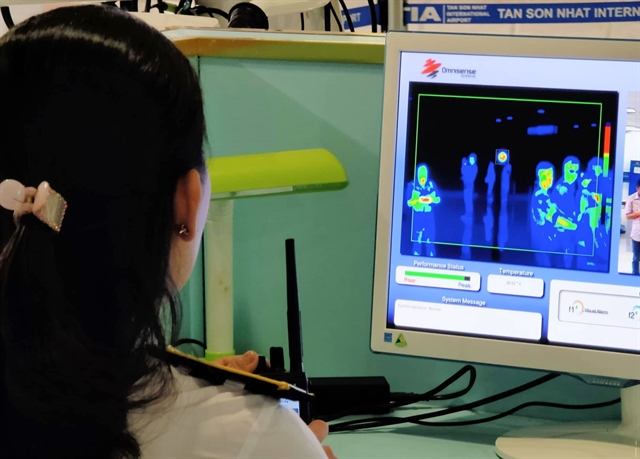 Society
Society

 |
| Thermal scanning at Tân Sơn Nhất International Airport in HCM City. — VNA/VNS Photo |
HÀ NỘI — Body temperature scanning will be used as a measure to monitor and detect monkeypox cases early, as prescribed in the guidelines for prevention and control issued by the health ministry on Monday against this escalating viral outbreak.
In case of suspected monkeypox symptoms, the passenger should be moved to a temporary isolation place for health authorities to perform an epidemiological investigation and preliminary medical examination, according to the guidelines on arrivals.
Based on the examination and epidemiological results, the passenger may be transferred to medical facilities for diagnosis and treatment or requested to self-monitor their health for 21 days from the entry date.
People arriving from monkeypox endemic countries or regions must monitor their health for 21 days from the entry date, according to the health ministry's guidelines. When symptoms like a rash, headache, fever, chills, sore throat, fatigue and swollen lymph nodes develop, they should limit contact with others and seek help from the nearest medical facility.
The health ministry also requested to strengthen event-based surveillance in the community as well as at health facilities to detect suspected cases early, especially at medical facilities specialising in dermatology and facilities for examination and treatment of sexually transmitted diseases.
To date, Việt Nam has not officially recorded any case of monkeypox.
According to the guidelines of the Ministry of Health, a suspected case is a person with an acute vesicular or pustular rash that is not explained by other common rashes (chickenpox, herpes, measles, skin infections caused by bacteria, gonorrhoea, or syphilis); and has one or more symptoms like headache, fever, swollen lymph nodes, muscle or body pains, exhaustion.
The case must also have one or several epidemiological factors: within 21 days before symptom onset, having had contact with a confirmed or suspected case, through direct physical contact with the skin or a skin lesion (including sexual contact) or contact with contaminated items such as clothes, bedding, personal belongings of the sick person; or have had sex with multiple partners within 21 days before the symptom onset.
People are urged to avoid close contact with open wounds, bodily fluids or personal belongings, especially those suspected to have been infected with monkeypox; frequently wash hands; cover their mouth and nose when coughing or sneezing.
Monkeypox is not a new disease. It was reported for the first time in 1958 in monkeys used for research purposes, and the first instance of the virus recorded on a human being was in 1970 in the Congo Republic. Since then, the disease has become endemic in Central and West Africa.
The disease had been cropping up across Europe since May, without links to previous outbreaks.
The WHO declared the escalating global outbreak a Public Health Emergency of International Concern on July 23, and as of August 15, over 35,000 cases have been logged in 92 countries, with 12 deaths.
Some countries near Việt Nam, such as Thailand, Singapore, China, Japan, South Korea have reported monkeypox cases.
The incubation period is usually between 6 and 13 days but can range between 5 and 21 days.
Symptoms may vary depending on the stage of the disease but appear similar to smallpox. The condition can clear up on its own within 2-3 weeks.
Smallpox vaccines appear to be partially effective against monkeypox in some studies.
The WHO has not recommended mass vaccinations against monkeypox, saying that it should be reserved for high-risk groups of people like doctors. — VNS